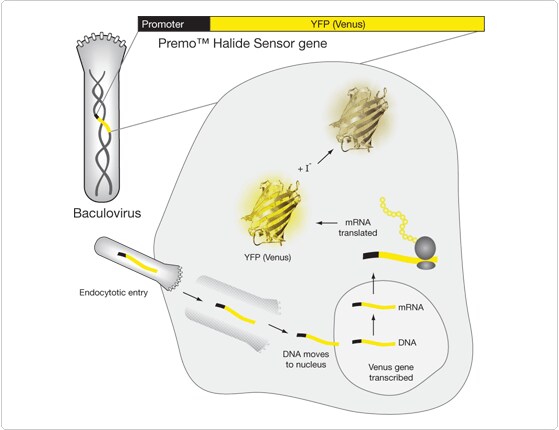Search
BacMam Gene Delivery and Expression Technology—Note 11.1
Baculovirus-Mediated Transduction of Mammalian Cells
BacMam technology uses a modified insect cell baculovirus as a vehicle to efficiently deliver and express genes in mammalian cells with minimum effort and toxicity.![]() We have combined the BacMam gene delivery and expression system with genetically encoded Premo sensors as well as with genetically encoded CellLight targeted fluorescent proteins (CellLight reagents and their targeting sequences—Table 11.1) to yield robust and easy-to-use cell-based assays (Figure 1).
We have combined the BacMam gene delivery and expression system with genetically encoded Premo sensors as well as with genetically encoded CellLight targeted fluorescent proteins (CellLight reagents and their targeting sequences—Table 11.1) to yield robust and easy-to-use cell-based assays (Figure 1).
BacMam particles carrying the biosensor or targeted fluorescent protein cDNA under the control of the CMV promoter are taken up by endocytosis. The viral DNA traffics to the nucleus where only the CMV promoter–driven gene is transcribed; baculovirus promoters are not recognized by the mammalian transcriptional machinery. Following transcription, the biosensor or targeted fluorescent protein mRNA is expressed in the cytosol and cells are soon ready to assay. This process begins within 4–6 hours after transduction and in many cell types is completed after an overnight period.
BacMam 2.0 vectors incorporated in our CellLight reagents extend the applicability of BacMam-mediated transgene delivery and expression. Cells such as primary neurons that were not amenable to BacMam transduction with version 1.0 (used in the corresponding Organelle Lights and Cellular Lights reagents) can now be transduced quantitatively in a simple, one-step process. The improved performance is due to inclusion of a pseudotyped capsid protein for more efficient cell entry as well as genetic elements (enhanced CMV promoter and Woodchuck Post-Transcriptional Regulatory Element) that boost expression levels.
Inducible, division-arrested or transient expression systems such as the BacMam system are increasingly methods of choice to decrease variability of expression in cell-based assays. Constitutively expressed ion channels and other cell-surface proteins have been shown to contribute to cell toxicity in some systems, and they may also be subject to clonal drift and other inconsistencies that hamper successful experimentation and screening. Moreover, the BacMam gene delivery and expression system provides a method for simultaneously delivering multiple genes per cell, an important feature when expressing multisubunit proteins.![]()

Figure 1. Schematic representation of BacMam transgene delivery and expression as exemplified by Premo Halide Sensor (P10229, Detecting Chloride, Phosphate, Nitrate and Other Anions—Section 21.2).
Advantages of the BacMam Delivery and Expression System
Baculoviruses have been used extensively for protein production in insect cells for over two decades; however, its use with mammalian cells is relatively new. BacMam technology has opened up new avenues for mammalian cell–based assays in drug discovery applications.![]() In addition to producing ready-to-use viral stocks, BacMam delivery and expression technology has many advantages when compared with lipids and other viral delivery methods:
In addition to producing ready-to-use viral stocks, BacMam delivery and expression technology has many advantages when compared with lipids and other viral delivery methods:
- High transduction efficiency across a broad range of cell types, including primary and stem cells
- Minimal microscopically observable cytopathic effects
- Highly reproducible and titratable transient expression
- Biosafety level 1 rating (baculovirus is not pathogenic to vertebrates and does not replicate in mammalian cells)
- Ability to simultaneously deliver multiple genes
Furthermore, it is possible to divide the BacMam-transduced, homogeneous cell population into aliquots that can be stored frozen for use at a later time, approximating the consistency of a stable cell line in a transient expression format.
For Research Use Only. Not for use in diagnostic procedures.